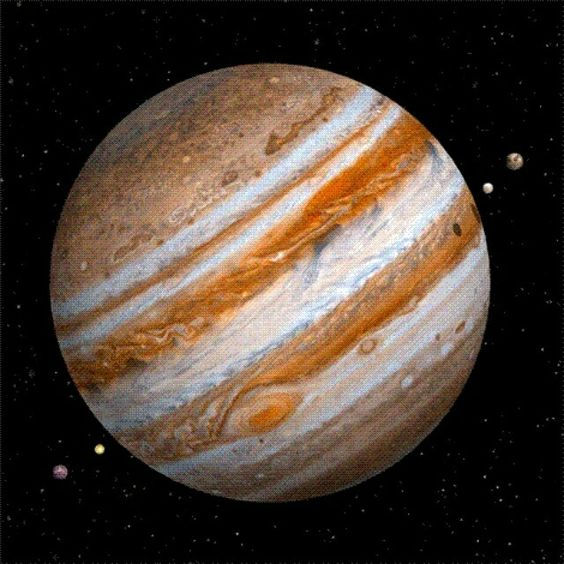Jupiter: ¼ of the Jovian Planets
- STEM To Go

- May 28, 2021
- 3 min read
Updated: Oct 4, 2021
Our solar system is located inside of the Orion Arm in the Milky Way Galaxy. It consists of different things such as a yellow dwarf star; which is the sun, eight planets, one dwarf planet, many confirmed and provisional moons, millions of asteroids, meteoroids, comets, and other kinds of celestial materials. The planets in our solar system orbit the sun in an elliptical path which is also called an orbit. The star-orbiting planets are divided into two main regions: the terrestrial or the inner planets (Mercury, Venus, Earth, and Mars) and the jovian or the outer planets (Jupiter, Saturn, Uranus, and Neptune); along with Pluto which is a dwarf planet at the furthest orbit. The two regions are divided by the “asteroid belt” in between the planets Mars and Jupiter.
When you hear the word Jupiter, what comes to mind is probably the Giant Red Spot but there’s more than just it. This gas giant is named by the Romans after their king of gods, Jupiter, who was also the god of the sky and thunder. It takes Jupiter only about 9 hours 56 minutes to complete its axis or in simple words, a day on Jupiter is equal to around 41.3% of a day on Earth. Jupiter is the fastest spinning planet in the Solar System. Even though its day is short, its year is long. It takes 11.86 Earth years to complete a full orbit around the sun because of its distance from the Sun.
This gas giant is the largest planet in the solar system with a mass of 1.898 × 10^27 kg and a radius of 69,911 km. It was composed of hydrogen and helium and it was formed around 4.6B years ago from swirling gas and dust pulled together by gravity. It took most of the mass left over after the formation of the Sun, ending up with more than twice the combined material of the other bodies in the solar system.

The planet has 79 moons whereas 53 have been named and 26 are awaiting official names. The Galilean moons (they were spotted by Galileo Galilei in the early 17th century) are the planet’s big 4 moons: Io, Europa, Ganymede, and Callisto. The planet’s rings were discovered in 1979 by NASA's Voyager 1 spacecraft, in which data show that they may be formed by dust kicked up as interplanetary meteoroids smashed into the planet’s tiny moons, and sadly they can only be seen when backlit by the sun. Moreover, it also has the famous Great Red Spot. First observed in 1831 by amateur astronomer Samuel Heinrich Schwabe, but it could be even older than that. Some astronomers have a theory that back in 1665 when astronomer Gian Domenico Cassini wrote about a "Permanent Storm," he was referring to the Great Red Spot. The Great Red Spot is a gigantic storm that circles the planet in its southern hemisphere. In the center, winds are relatively calm, but on its edges, wind speeds reach up to 680 km/h. The storm is contained by an eastward-moving atmospheric band to its north and a westward-moving band to its south. Those swirling bands are also what formed the storm in the first place and have kept the storm spinning for more than a century.
Jupiter’s surface gravity is 24.79 m/s² which means a 50kg person would weigh 126.35 kilograms. The planet’s density is 1.33 g/cm³ which means it would sink in water (of course, only if you could lift it and drop it in the water). Due to it being a gas giant, it doesn’t have a true surface which means there’s nowhere for spacecraft to land on and even if it does have a surface, its extreme pressures and temperatures deep inside the planet will crush, melt and, vaporize any spacecraft trying to fly into it. Despite that, many satellites have successfully visited and studied it.
Fun fact #1: The sky can rain diamonds on Jupiter.
Fun fact #2: Jupiter has the same ingredients as a star, but it did not grow massive enough to become a star and that is where it got the nickname “a failed star”.
Sources:
453. “How Did Jupiter Get Its Name?” Universe Today, 25 Dec. 2015, www.universetoday.com/14479/how-did-jupiter-get-its-name.
Wikipedia contributors. “Jupiter.” Wikipedia, 27 May 2021, en.wikipedia.org/wiki/Jupiter.
“In Depth | Jupiter –.” NASA Solar System Exploration, solarsystem.nasa.gov/planets/jupiter/in-depth. Accessed 28 May 2021.
The Nine Planets. “How Many Moons Does Jupiter Have? | Names, Locations & Number.” The Nine Planets, 29 Sept. 2020, nineplanets.org/questions/how-many-moons-does-jupiter-have.
“Jupiter Moons.” NASA Solar System Exploration, solarsystem.nasa.gov/moons/jupiter-moons/overview/?page=0&per_page=40&order=name+asc&search=&placeholder=Enter+moon+name&condition_1=9%3Aparent_id&condition_2=moon%3Abody_type%3Ailike.
Wikipedia contributors. “Galilean Moons.” Wikipedia, 27 May 2021, en.wikipedia.org/wiki/Galilean_moons#:%7E:text=The%20Galilean%20moons%20.
Wendel, JoAnna. “Jupiter’s Great Red Spot: Our Solar System’s Most Famous Storm.” Space.Com, 19 Oct. 2019, www.space.com/jupiter-great-red-spot.html.
“The Planet with Diamond Rain.” SCIplanet, www.bibalex.org/SCIplanet/en/Article/Details?id=12453.
Written by: Sonalen Saing




Comments